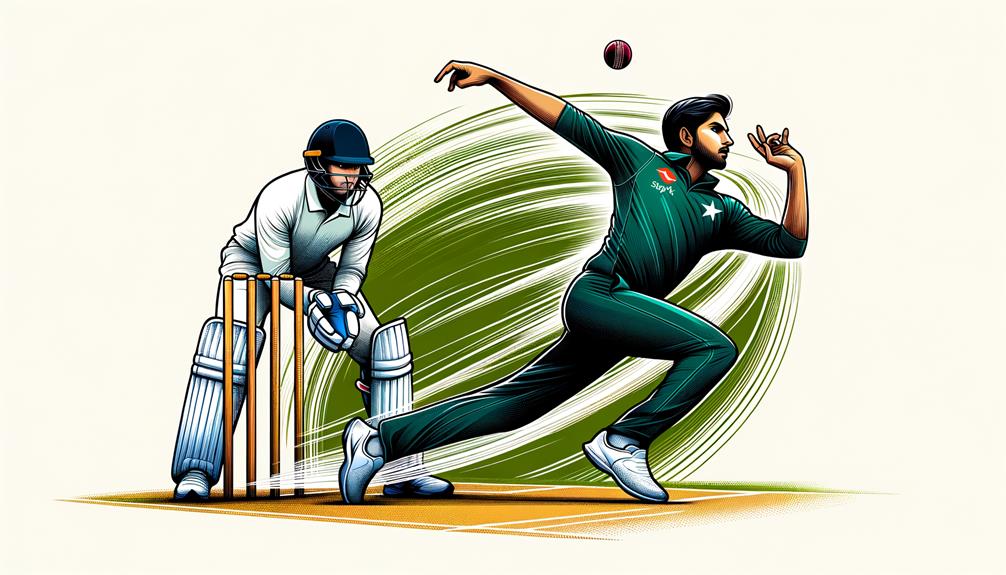Share This Article
In cricket, ‘around the wicket’ and ‘over the wicket’ are strategies a bowler uses to stump you, the batter. When a bowler goes ‘around the wicket,’ they approach from your non-dominant side, creating a tricky angle that can confuse and challenge you; this angle can lead to vital mistakes on your part. Conversely, ‘over the wicket’ means the bowler approaches from your dominant side, offering a more straightforward attack aimed right at your stumps. Each method serves certain tactical advantages, depending on your weaknesses and the pitch conditions. Mastering both gives the bowler a significant edge, keeping you on your toes and potentially changing the course of the game.
Bowling Technique: Around the Wicket

When bowling around the wicket, you angle your approach from the umpire’s off-side to create a challenging delivery angle for the batter. This method can confuse the batter and increase your chances of taking a wicket.
It’s essential to master your bowling grip and wrist position to maximize the effectiveness of this style.
Your bowling grip is foundational. Hold the ball with your index and middle fingers on either side of the seam, and your thumb resting lightly underneath. This grip allows for better control and spin.
As you run up to the bowl, keep your wrist firm and slightly cocked. The wrist position is key in determining the ball’s trajectory and spin after it leaves your hand.
Over the Wicket Basics Explained
Switching to over the wicket, you’ll approach from the umpire’s on-side, offering a direct line of attack to the batter’s stumps. When you bowl over the wicket, your bowling grip and the delivery angle are essential in determining how effectively you can target these stumps. You might hold the ball with a seam upright to encourage swing, or you could position it for spin, tweaking your grip slightly to manipulate the ball’s movement off the pitch.
The delivery angle, when you’re bowling over the wicket, typically allows for a more natural angle into the right-handed batter, making it easier to hit the off-stump or even aim for a leg-before-wicket decision.
As a bowler, you’ll deliver the ball with strategic placement of your front foot close to the popping crease, maximizing the angle while remaining within the rules.
Practising your approach and mastering the subtleties of your grip and the delivery angle can considerably enhance your effectiveness. By refining these elements, you’re not just throwing the ball; you’re strategically placing it to challenge the batter at every opportunity.

Tactical Variations in Wicket Approach
Exploring tactical variations in your wicket approach—whether around or over—can greatly impact your game strategy and outcomes.
When you’re bowling around the wicket, you’re creating unique bowling angles that can confuse batters and disrupt their rhythm. Especially on wicket conditions that offer uneven bounce or excessive spin, these angles can be a game-changer. By adjusting your position relative to the wicket, you’re able to target the blind spots in a batter’s swing, potentially leading to more edges and missed hits.
Moreover, switching between around and over the wicket can keep batters guessing, making it harder for them to settle and build a rhythm. This uncertainty can lead to errors in judgment and technique, giving you an edge.
However, it’s not without drawbacks. Adapting to these variations requires practice and precision. Misjudgments in line and length when switching approaches can easily backfire, offering batters easy scoring opportunities.
Therefore, you must assess the pitch and the batter’s weaknesses before deciding your approach. Being flexible and adaptive, while maintaining control over your delivery, can enhance your effectiveness and keep your opponents on their toes.
Over the Wicket Tactical Uses
Over the wicket bowling offers strategic advantages by allowing bowlers to deliver more conventional line and length, though it may reduce the element of surprise against experienced batters.
When you’re bowling over the wicket, your primary bowling angles are more predictable, but this predictability has its perks. It lets you consistently challenge the batsman’s off-stump, forcing them into making defensive cricket shots.
However, you’ve got to evaluate the batsman’s adjustments. Skilled players will quickly adapt to your angles and may start to anticipate your deliveries better. This is where you need to mix up your speeds and seam positions slightly within the over the wicket framework to keep them guessing.
Using over the wicket also generally provides a better angle of attack against opposite-handed batters. For instance, if you’re a right-handed bowler facing a left-handed batsman, your deliveries naturally angle into them, potentially pinning them on their pads for a leg-before-wicket (LBW) decision.
But remember, while this angle can be advantageous, it also gives the batsman a good look at your line, enabling them to play more comfortably if they aren’t sufficiently challenged.

